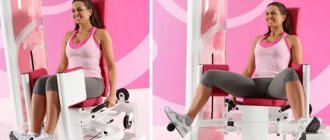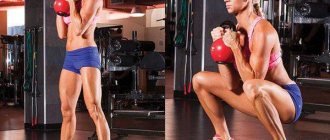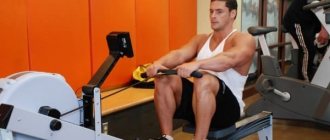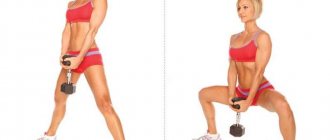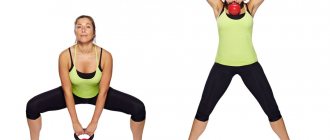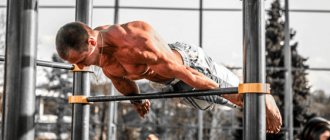Pros and cons of the exercise
Main advantages:
- Give a significant load on the chest and triceps.
- They involve a large number of muscle fibers (almost all groups of the upper body).
- The ability to progress endlessly, regardless of physical fitness level (using weights).
- Significant increase in strength and endurance.
- Building natural muscles and improving definition.
- Strengthening tendons and ligaments.
- Not only does it not create a negative compression effect on the vertebrae, but it also relieves muscle hypertonicity due to being in a hanging position.
- Another important feature of chest-style dips is that the pectoralis major receives additional stretching. This promotes muscle growth and improved posture (by turning the shoulders back).
The exercise has no obvious disadvantages , except for the need to perfectly follow the technique. Often athletes perform bench presses at a fast pace with an emphasis on the number of reps. This is only justified from a competitive point of view (when the goal is to do the maximum number of repetitions). For developing strength, mass and endurance, this option is less effective than concentrated movement at a moderate pace.
Dips for chest muscles
If you are wondering whether it is possible to pump up your chest on the uneven bars and how, then just set yourself a goal and the expected results will soon appear. The exercise is considered one of the best for pumping the muscle fibers of the chest and abs. Chest-style exercises are sometimes called wide-grip push-ups. But, contrary to the name, your hands should be placed slightly wider than shoulder level. This is explained by the fact that during training it is possible to get injured if the distance between the hands is wide and it is difficult to perform the exercises if it is small.
What muscles work when doing dips?
The parallel bar press is a basic exercise. This is a universal movement that is used to pump different muscle groups. Minor changes in technique can influence which muscles are used in dips.
- Chest muscles (mostly large).
- Triceps (emphasis on the long head).
These areas bear the main load (it can be changed by changing body position). Additional load and role in stabilizing the position of the arms and body falls on:
- Rotator cuff muscles.
- Front delts.
- Small pectorals.
- Serrated.
- Diamond-shaped.
- Trapezoid (lower part).
- Buttocks and abdominal area (work statically to stabilize the body).
The uniqueness of the movement lies in the fact that it applies to two different muscle groups at once. Despite the same type and similar technique, triceps and chest dips are different exercises.
What muscles work
Before listing the muscles involved in parallel bar push-ups, let us note an important nuance. The uniqueness and effectiveness of this exercise lies in the fact that the athlete can change the target muscle group, slightly adjusting the technique.
Depending on the technique, the athlete forces either the triceps or the pectoral muscles to work. In addition, the back works, as well as a group of synergistic muscles (secondary load).
By the way, no matter how you do dips, the triceps work in any case, but to a greater or lesser extent. The pectoral muscles will always strive to “take away” the load. Therefore, in order to force a specific muscle group to work, the athlete must clearly understand the different techniques for performing the exercise.
So, what muscles are developed by dips, let’s list them:
- Triceps (back of the arms);
- Large pectorals;
- Front delts;
- Ligaments of the shoulder, elbow and wrist joints;
- Press;
- The back muscles also work;
- If you bend your legs back and fix the position in a static position, you will force the thigh biceps and buttocks to partially work.
The influence of grip width on muscle development
The width of the grip determines the emphasis of the load on the muscles.
- If the bars are wide apart, this is a variation of the parallel bars for the pectoral muscles. It is considered more technically difficult and requires better physical preparation.
- Dips to work the triceps are performed with a narrow grip. A simulator in which the crossbars are located closer to each other is suitable for this.
If there is only one exercise machine in the gym and on the playground and the width of the bars cannot be changed, the emphasis can be shifted to different muscles by tilting the body.
Wide grip dips
It is not entirely correct to consider the technique of push-ups on parallel bars with a wide stance of the arms as an option exclusively for the chest. This is due to the fact that a considerable part of the load falls on the front delta (as in other presses).
The technique is considered one of the most difficult, and therefore is not suitable for beginners (with weak muscles, you can easily get a sprain in the chest area).
Another difficulty when working with a wide grip is accessing the uneven bars. It also requires certain dexterity, technique and physical preparation, so beginners are always recommended to start with machines with narrow bars.
Close grip dips
This type of work is considered classic, regardless of goals and shifts in emphasis. With a narrow arm position, the athlete is able to perform more repetitions and sets, increasing training volume and efficiency. This ensures faster progression.
It is important to consider that, unlike wide-grip dips, narrower hand placement increases core stabilization. Shifting the emphasis to the chest or triceps in this case is done by changing the position of the body.
How to do dips on parallel bars correctly
1. Jump onto the bars and lower your shoulders.
The Lifehacker Telegram channel contains only the best texts about technology, relationships, sports, cinema and much more. Subscribe!
Our Pinterest contains only the best texts about relationships, sports, cinema, health and much more. Subscribe!
Photo: Alexander Starostin
2. Make sure that your shoulders do not rise throughout the exercise.
3. Straighten your arms, but do not lock your elbow joint. The elbow should remain slightly bent - this will keep the muscles under tension throughout the entire approach.
Photo: Alexander Starostin
4. Lower yourself down until your shoulders are parallel to the floor.
Photo: Alexander Starostin
5. Make sure your elbows go back and not to the sides. This mistake puts stress on the shoulders and elbows and can lead to inflammation and pain.
Photo: Alexander Starostin
This exercise is quite difficult, so it may take you months to complete your first dip.
Technique for push-ups on the pectoral muscles
This exercise is recommended for developing the pectoral muscles. It gives a powerful load and additionally stretches the muscles.
Technique:
- Step onto the bars and get into position. Lean your body forward, tilting your head slightly. Bend your legs at the knees (this will further increase the degree of inclination).
- Begin to slowly lower yourself down without changing your body position. Movement occurs only in the shoulder and elbow joints.
- When your elbow is bent at a right angle, without pausing, return to the starting position, pressing your body up.
At the top point when working on the chest, it is recommended not to fully extend the elbow. This will reduce stress on the triceps and increase the efficiency of the movement for the target muscle.
Dips with emphasis on triceps
As mentioned at the very beginning of the article, this option is more basic. It is used by a large number of athletes around the world. Push-ups with an emphasis on the triceps are especially good for beginner athletes. They will be able to feel the work of this muscle and strengthen their ligaments. This will be an excellent preparatory basis for further work with heavy weights. In order to shift the focus to the triceps, two factors must be taken into account.
Firstly, body position. The more we lean forward, the more the load shifts to the pectoral muscles. Therefore, we must keep our body as straight as possible. A slight tilt is done in order to reduce the load on the claviobrachialis muscle.
Secondly, grip width. In order to work the triceps well, we need to isolate them from the pecs. Narrow or medium-width beams will help us with this. By performing push-ups on them, it will be easier for us to move our elbows back. This will stretch all 3 heads of the triceps more. And breasts will be practically excluded from the movement. But still, they will also receive the same load.
Initial position:
For this type of dips on the uneven bars, ordinary standard parallel bars are best suited for us. The narrower the distance between them, the better.
- We grab the bars with our hands, with a neutral grip (palms facing each other).
- Next, we need to put emphasis on them. In order to do this, we can push off the ground a little with our feet. And at the same time straighten your arms. If it's so hard for you to do. Then take some kind of stool and climb onto the bars from it.
- While standing, release your shoulders down and stretch your trapezius as much as possible.
- The body is slightly tilted forward. So that we feel comfortable. The main thing is not to overdo it, and not to shift all the emphasis from triceps to pectorals.
- The legs are bent at the knee joint.
Performance:
- We take a deep breath and bend our arms at the elbow joints.
- Hold this position for a short time to maximize the stretch in your triceps.
- As we exhale, we straighten our arms with effort and return the body to its original position.
Our main task is to control the movement itself. After completing the approach, we carefully lower ourselves to the floor. Don't jump off the bars. You won’t surprise anyone with this, but you can easily lose your balance or twist your leg.
Recommendations for implementation
- Don't lower your body too much. A 90° bend in the elbow joint is sufficient. If you feel like you can go a little lower, then go ahead. But if at the lowest point you feel pain in the shoulder joint. Then you have clearly overdone it, and you should reduce the amplitude a little. In short, experiment and find the optimal range of motion.
- When doing dips, your elbows should go back, not to the side. This is done in order to exclude breastfeeding from the work.
- Do not fully extend your arm muscles at the top. This will remove all the stress from the triceps and shift it to the elbow joints. This will not affect the growth of the triceps in any way, but the risk of injury will be very high.
- Bending and extending your arms should occur under your control. Avoid inertial movements. Our main task is to feel the work of the triceps, and not to finish the exercise as quickly as possible.
- Do not bend your legs at the hip joint. This will cause your torso to lean forward and shift the emphasis from the triceps to the pecs.
- The gaze should be directed forward. This way we will avoid rounding in the back.
- Avoid swaying while moving.
- Make sure that your shoulders are pulled straight back and not to the sides.
If you adhere to all these rules, and also bring the execution technique to perfection. Then your progress will not be long in coming. And what “trauma” is will not be familiar to you.
Triceps dip technique
This type of dip is used to shift the load on the triceps. The chest also takes part in the movement, but to a lesser extent than when tilting the body.
Technique:
- Exit and take the starting position. The arms should be fully straightened, the body forms a straight line, perpendicular to the floor.
- Slowly lower your body down, bending your arms.
- At the bottom point, take a minimal pause and return to the starting position.
Unlike the chest technique, in this variation it is important to straighten your elbows completely. This will allow you to maintain concentration on the triceps muscle and use it as much as possible during the movement.
What muscles are used by dips?
Dips use a very large number of important pressing muscles. Such as:
- Triceps. 3 heads work at once. Long, medial and lateral. At the same time, you need to understand that when performing any of the push-up options, the triceps will receive a load. It’s just that with an emphasis on it it will be much greater.
- Delta. Not all deltoid bundles take an active part, but only the anterior one.
- Pectoral muscles. We are talking about the lower sections, the so-called abdominal (abdominal) region of the chest. It is push-ups on the uneven bars that allow you to work out these departments in detail.
- Coracobrachialis muscle. This is a small muscle that is also involved in this exercise. It is located under the anterior delta. If the technique is incorrect, it can be easily injured.
- Serratus anterior muscle.
Responsible for the movement of the shoulder blades, namely their spreading to the side. Therefore, he actively takes part in the moment of the press itself.
As you can see, the exercise really has the right to be called basic, since it involves a large number of muscles. And of course several joints: shoulder and elbow. For people who want to achieve larger muscle masses, this is good news.
Features of push-ups on uneven bars with weights
You should only switch to dips with additional weight after your bodyweight progression has slowed or stopped altogether. There is no point in performing a movement in a high-repetition style, except for competitions for the maximum number of repetitions or endurance training. If the goal is to increase strength or mass (for which weights are used), the greatest effectiveness will be achieved by working in a mode of 6 to 12 repetitions.
The technique when performing push-ups on uneven bars with weight does not change and depends on which muscle needs to be loaded:
- Chest – with the body tilted forward.
- Triceps - body in an upright position.
A weight or pancake is used as weights. The weight is hung on the belt using a hook or clamp immediately before the start of the set. Removed immediately after finishing the approach.
What muscles swing on the uneven bars?
Which muscles work when doing dips depends on the version of the exercise.
In general, parallel bars allow you to train your triceps, shoulders and pectoral muscles. They also allow you to load your abdominal muscles.
The point of all parallel bars exercises is that you push your body with your hands against parallel bars in a vertical plane. Some skilled people are able to perform complex movements with their feet up, but this is more in the realm of gymnastics. Most people exercise in the usual position for everyone - feet down. We will analyze exactly the last case.
The variability of muscle work depends on the inclination of your body relative to the vertical and on the distance between the bars.
For example, let's take the triceps brachii muscle. The triceps makes up the bulk of the muscle volume of the arm above the elbow. About 70 percent. Therefore, this muscle will be mainly responsible for the volume of your arms. Push-ups will be very useful for working out your triceps. They noticeably increase the girth of the shoulder.
Try it yourself - a month before training, measure the volume of your triceps (arm straight). Consistently perform 3-4 sets of dips every 3 days. After a month (it turns out that about 10 training sessions will take place), repeat the measurements. Most likely, you will find a progress of at least 1 cm relative to the old volumes. This is how parallel bars affect the triceps.
Let's look at exercise options that focus on different muscle groups.
Dips with elastic band
There are two options for using rubber bands.
- One allows you to ease the load in order to correctly do push-ups on uneven bars at a low level of physical fitness (used by beginners).
- The second option is used to increase the load (instead of weights).
To reduce the load
- Secure the rope between the beams so that it hangs in the form of an open loop.
- Step onto the parallel bars and lower your shins onto the rope. This will relieve some of the stress from pushing the body out and make movement easier.
To increase the load
Hook the ends of the rope onto the bars, passing the loop over your shoulders behind your neck. When performing movements in the negative phase, the tourniquet will create additional resistance.
Choose a band with a tension level that is appropriate for your fitness level. Read more about elastic bands for pull-ups →
Dips for advanced
Angled parallel bars push-ups . Having taken the starting position, you straighten your legs at the knees and bend the hip joints at 90 degrees to the body. Having taken this starting position, you then perform the “triceps” version of dips on the uneven bars, constantly keeping your abs tense. In this version, the quadriceps, rectus and oblique abdominal muscles work very powerfully, and the chest muscles are included as stabilizers.
Push-ups from pillars. Instead of parallel bars, a pair of pillars is used, the stability of your hands decreases, and accordingly, stabilizer muscles are activated: in this case, the muscles of the rotator cuff of the shoulder joint, biceps, muscles of the forearms, intercostals, serratus, and pectoralis minor.
Dips with a reverse grip , with your palms facing outward rather than inward. It turns out that when lowering the body to the lowest point, the elbows go to the side, the body remains almost vertical, and the triceps takes up most of the load. Not worth doing unless you have some flexibility in your wrists.
Upside down parallel bars . In the starting position, you stand on your hands on the uneven bars, your body is perpendicular to the floor, your head is looking down, your legs are looking up. In this option, all core muscles are powerfully involved, the dynamic load falls on the deltoid muscles and triceps shoulders.
© alfa27 — stock.adobe.com
Reverse grip dips
This is a difficult technique that should only be attempted once the lifter can perform 4-5 sets with perfect form without weight. This option puts a lot of stress on the triceps , and also involves the forearms (than with regular push-ups).
Features of execution:
- The general technique does not change, except for the position of the hands (reverse or pronated grip).
- It is recommended to avoid full range of motion initially to minimize injury. Start with partial range of motion, gradually increasing the extension of the arm at the elbow.
- Do not lean your body forward. Try to perform the movement so that your body remains upright.
Emphasis on the pectoral muscles
In order to transfer some of the load to the pectoral muscles, we need to change the technique so that it includes the mechanics of bringing the shoulders together. To do this, we, firstly, spread our elbows slightly to the sides, and, secondly, tilt our body forward. The exercise works the lower part of the chest as much as possible. The pectoral muscles are well stretched at the lowest point, which increases the amplitude of the movement, and, consequently, its effectiveness.
Do not try to perform the exercise on bars that are too wide. This may cause injury. The optimal distance between the bars is slightly wider than your shoulders.
The technique of parallel bar push-ups with an emphasis on the chest is as follows:
- Jump onto the apparatus, turn your elbows slightly to the sides and tilt your body forward about 30 degrees.
- As you inhale, lower your body down, spreading your elbows to the sides. Do not try to separate them too widely - everything is within the limits of anatomical comfort. At the bottom you should feel a good stretch in your lower chest. Focus on a 90 degree angle at your elbows.
- As you exhale, contracting your pectoral muscles as much as possible, lift yourself to the starting position. At the top point, squeeze your chest even more and hold for 1-2 seconds.
As with the triceps, when training your chest for mass, perform 10–15 reps in 3–4 sets. Once you solve this problem, master weighted dips.
In a chest training program, the exercise can be placed, for example, after bench presses.
How can you replace dips?
If doing an exercise is contraindicated for medical or other reasons, then only safe movements that load the same muscle areas can replace it. For example:
- Bench press.
- Dumbbell bench press.
- Bringing the arm back while bending over.
- Close grip bench press.
- French presses.
Also, for athletes who cannot perform exercises on the uneven bars, these movements will serve as an excellent basis for increasing strength and technically correct execution of all elements.
What muscles work on the uneven bars?
Let's start with standard parallel bars exercises, where you stand between two pipes, take a stand and lower yourself. A lot depends on the angle and amplitude of the repetitions.
- For example, if you place your elbows out to the sides when doing dips, you will help stretch the lateral part of the pectoral muscle, which will enhance its development. In principle, the pectoral muscles are quite easy to pump in this way.
- If you press your elbows to your body while doing push-ups on the parallel bars, the emphasis is on the triceps.
- When leaning back, you can hit the same triceps and lats much more strongly.
What is better than dips, bench press, or floor push-ups?
Each exercise has its pros and cons. The clear disadvantage of parallel bars has always been the limiting factor in progression, since the movement was performed with the weight of one’s own body. However, in gyms and playgrounds, progression is ensured by push-ups on uneven bars with an elastic band or weights, so this disadvantage becomes irrelevant.
For the highest quality and full development of all muscle areas (from different angles), it is recommended to use all three exercises in the training program. The push-up option can be replaced with a bench press, since these are the same type of movements.
Dips on parallel bars - benefit or harm?
The dip exercise doesn't have the best reputation. The reason is frequent shoulder injuries and a large load on the joints in general. Yes, if you are a beginner, dips can seriously hurt. Just like barbell squats and deadlifts.
But for those who can do dips with proper form, this exercise is great for building upper body muscles.
Is it possible to injure your shoulders?
Yes, you can.
But with the right technique, parallel bars will be beneficial. How to correctly:
- move your shoulder joints and shoulder blades back
- don’t lift your shoulders up to your ears, lower them down
- bring your shoulder blades together towards your spine
Yes, dips with incorrect technique are more dangerous than any other upper body exercise. But if you learn the correct technique, then this exercise, on the contrary, is good for your shoulders and joints.
Recommendations
To make the exercise as effective as possible, you must adhere to the basic recommendations:
- It is important to understand which muscles are pumped in dips. This will allow you to perform the movement correctly.
- You must not allow yourself to fall down by inertia. This will not only increase the risk of injury, but will also reduce overall efficiency.
- The back should always be straight. Slouched shoulders or roundness in the upper back will place increased stress on the vertebrae and increase the risk of injury.
- Exhalation is always carried out during the upward movement.
Also, to increase the productivity of movement, it is necessary to concentrate tension on the muscles. This will improve neuromuscular communication and increase the overall benefits of exercise.
What muscles are involved?
The question that interests any beginner when he learns about this exercise is what muscles work during push-ups? Which muscle groups will work depends on the technique, grip, and body position, but in the classic version the main load is applied to the triceps brachii, chest, and triceps. During execution, almost all the muscles of the body become toned, so the ease of execution depends not only on the development of the muscles of the upper limbs, but also on general physical fitness.
Exercises on the uneven bars promote the development of almost all upper muscle groups, for example, the load falls on the pectoral muscle, triceps, deltoids, and the flexibility of the shoulder girdle increases. By changing the position of the body, its angle, you can shift the load to other muscles: by tilting the torso forward, the pectoral muscle will do more work, while an even position will shift the load to the triceps.
As mentioned above, dips on the uneven bars tone the whole body, using the abs, back, and legs.
